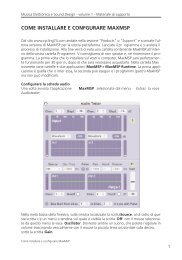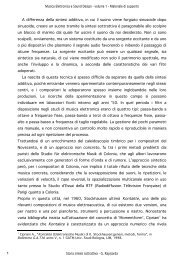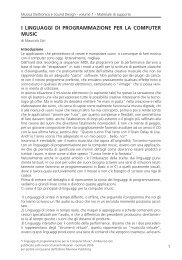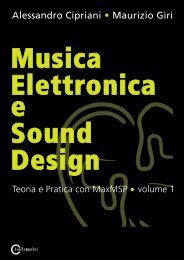programming with max/msp - Virtual Sound
programming with max/msp - Virtual Sound
programming with max/msp - Virtual Sound
You also want an ePaper? Increase the reach of your titles
YUMPU automatically turns print PDFs into web optimized ePapers that Google loves.
Electronic Music and <strong>Sound</strong> Design - Introduction<br />
to consider the recommendations of the book and to code in a systematic<br />
way. Max/MSP is a true musical instrument, and learning to play it should be<br />
approached as one would approach the study of a traditional instrument (such<br />
as a violin). As <strong>with</strong> any instrument, the reader will find it necessary to practice<br />
regularly, and to stay sharp on basics while gradually acquiring more complex<br />
techniques. By approaching the software in this way, fundamental techniques<br />
and technical insights can be retained once they have been acquired.<br />
Bibliography<br />
The decision was made to limit the bibliography in this book to a list of only the<br />
most absolutely essential reference works, and, of course, a list of the books and<br />
articles cited in the text. A more comprehensive bibliography is available online.<br />
Before Beginning<br />
To begin working <strong>with</strong> this book, you will need to download the interactive <strong>programming</strong><br />
examples, which you will find at the support page for this text. While<br />
reading the theory chapters, you will find constant references to the examples<br />
contained in this downloadable archive. To work interactively <strong>with</strong> the <strong>programming</strong><br />
chapters of the book, you will need to download the <strong>Virtual</strong> <strong>Sound</strong> Macro<br />
Library from the support page mentioned above. It will also be necessary to install<br />
MaxMSP, which is available at the Cycling74 website: www.cycling74.com.<br />
The same web page contains detailed instructions regarding how to install MaxMSP<br />
and the macro library correctly; look for the document entitled “How to Install and<br />
Configure MaxMSP”.<br />
Always check the support page for patches (MaxMSP programs) related to<br />
the practice chapters of this book, as well as the audio files for the reverse<br />
engineering exercises.<br />
THANKS<br />
We wish to thank Gabriele Cappellani, Salvatore Mudanò and Francesco<br />
“Franz” Rosati for their patience and long hours of work, and Dario Amoroso,<br />
Joel Chadabe, Mirko Ettore D’Agostino, Luca De Siena, Eugenio Giordani,<br />
Gabriele Paolozzi, Giuseppe Emanuele Rapisarda, Fausto Sebastiani, Alvise<br />
Vidolin and David Zicarelli for their generosity.<br />
DEDICATIONS<br />
This text is dedicated to Riccardo Bianchini, who would have wanted to participate<br />
in the production of this teaching text, but who, unfortunately, passed<br />
away before the work began. We have collected some of his materials, revised<br />
them, and cited them in a few of the sections on theory. This seemed to be<br />
a way to have Riccardo still <strong>with</strong> us. A particular thanks goes to Ambretta<br />
Bianchini for her great generosity and sensitivity during these years of work.<br />
Alessandro Cipriani and Maurizio Giri<br />
from “Electronic Music and <strong>Sound</strong> Design” Vol. 1 by Alessandro Cipriani and Maurizio Giri<br />
© ConTempoNet 2010 - All rights reserved<br />
XIII







